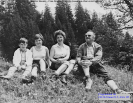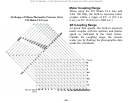This table does not necessarily apply when
using a lens of a different focal length. If
you are using a telephoto lens, for instance,
any subject movement and the least bit of
camera shake can have a magnified effect on
image sharpness. For a telephoto it is neces-
sary to use faster shutter speeds than with a
standard lens under the same lighting con-
ditions. It is generally said that, for sharp
image results in hand-held shooting, the
minimum shutter speed should be equal to
or faster than 1 divided by the focal length
of the lens. This means that for a 100mm
lens, the shutter speed should be at least
1/125 sec.; for a 200mm lens, it should be at
least 1/250 sec.
There are other considerations in the se-
lection of shutter speed. You can usually
freeze the action of relatively slowly moving
pedestrians or traffic at a shutter speed of
1/250 sec. The same is not necessarily true
of a rapidly moving bicycle. Instead of
freezing the action, you may want to empha-
size it by blurring some part of the picture.
For instance, you could blur a moving
subject with a relatively slow shutter speed.
Or, using a panning technique, turning the
upper part of your body to follow the
subject's movement, at a relatively slow
shutter speed of perhaps 1/30 sec., you can
blur the background to stress the movement.
In this last technique, it is best to continue
panning as you release the shutter.
The direction of movement should also be
considered. A subject moving directly across
in front of the camera will be blurred to a
greater degree than a subject which is mov-
ing diagonally across or is heading straight
for or away from the camera and may
require faster shutter speeds than you would
use considering speed of movement alone.
In fashion photography, a rapid succession
of shots at fast shutter speeds, or using a
flash while the model continuously changes
the pose, helps to capture natural expres-
sion.
Not For Resale – Free Download at http://www.joe-chan.com/manuals
–
41
–


















